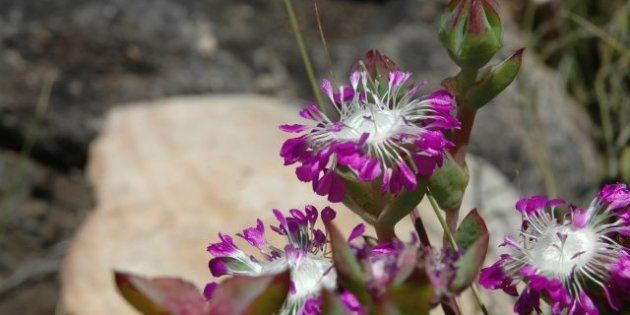
The wine farmer's wife looked out over the vast Boland vineyard and sighed. "We really love nature, you know. We spend at least one week a year in the Kalahari." I was there because her husband had (allegedly) ploughed vegetation sans the requisite environmental permission. Nearly one hundred hectares of endangered fynbos and wetlands, gone. I remind her that the cornucopia of threatened plants now under vineyard was equal to any ten thousand hectare block of Kalahari. "Oh," she says, "we didn't know."
The exchange is eerily reminiscent of conversations at (some) dinner tables about the obtuseness with which too many South Africans go through life. The search term "apartheid we didn't know" produces more than 64000 hits and the fact that rooibos is a kind of fynbos would sabotage many an otherwise well-educated 30 Seconds player. But y'all know Cricket SA marketing says that the first flower to bloom after a fire is the protea. WRONG, it's actually fire lilies from the genus Cyrtanthus.
South Africa has always been a water scarce country with drought waiting in the wings. Our annual precipitation range of between 464mm to 600mm puts most of our land in the semi-arid category, though you wouldn't know it looking at the amount of perfectly manicured lawns and pools around you.

Ever the tardy guest at a number of overdue engagements, South Africans have not interrogated what it means to live in 30 driest country on earth. And it can start with something as simple as a pretty garden. It's no secret that individual homes in the Johannesburg suburb of Waterval are lapping up 159 000 litres of potable water in pursuit of the lawn to top all lawns, fringed with roses and thirsty subtropical oddities. This obsession supports an assertion that humans have some kind of artificial mystic link to lawns and attach exaggerated meaning to a well-manicured sward around the house.
Last year this, I spoke about this water crisis on Twitter (the infamous single RT #lawnsmustfall) and again in a radio interview. Outside of the verdant suburbs, farmers were struggling to keep crops alive and having to make intense sacrifices. Yes, 2015 turned out to be the lowest recorded rainfall year since 1904 and no, we really couldn't be arsed. Now Cape Town deals with level three water restrictions and most of Gauteng sits perched precariously on the cusp of water shedding. And still, water wasters continue to trend, just look around on your next drive.
South Africa has a generous collection of over 20 000 indigenous plants suited for every area and yet the average gardener draws from a pretty small indigenous palette and the large nurseries still stock mostly conventional garden plants from all over.
This lax attitude toward the horticultural (and water-saving) potential of our internationally renowned botanical treasure chest is not new. In 1822 renowned English botanist and explorer William Burchell was appalled at the Cape elite's tendency to embrace "the common garden flowers of Europe" while indiscriminately referring to the numerous fynbos species as bosjes. As environmental historian Lance von Sittert notes: "A preference for the exotic over the indigenous was a hallmark of botanical tastes in all settler colonies" until later on when a type of fynbos nationalism won the approval of many. Because this is South Africa, this early conservation came at the expense of poor brown people's livelihoods (seriously, read the article).
Now summer is here and it is the age of water austerity. We must examine how and why we garden and rethink some of our gardening habits.
First, do nothing. #WaterCrisis, people! It's not #SlightLackOfWater or #ATadDry. The choice is green garden or water shedding. Take this opportunity to save time and money and see which of your plants survive with minimum assistance. Those are the keepers to build your gardening squad around.
Seasonality – in the Cape summers, it is hot and windy. Similarly; the dry frosty Highveld winters are hell for delicate garden plants. We should embrace this and accept that, beyond sports fields, some recreational areas and botanical gardens; we wear our wilted annuals as a badge of pride and resolve to select better next year. This also goes for the establishment of new gardens. Hold your project for the beginning of the rainy season and save on irrigation and inevitable mortalities.
Accountability – for every sneaky early morning sprinkling of the lawn, you're drawing from the reservoirs and dams which are already under stress and robbing yourself.
(Enthusiastic gardener DJ Khaled knows what's up.)
This is one area where you have complete control and can deliver a real societal contribution. Failing to act, or ignoring the #watercrisis edges you towards the lawlessness we like to feel superior to. Own it.
